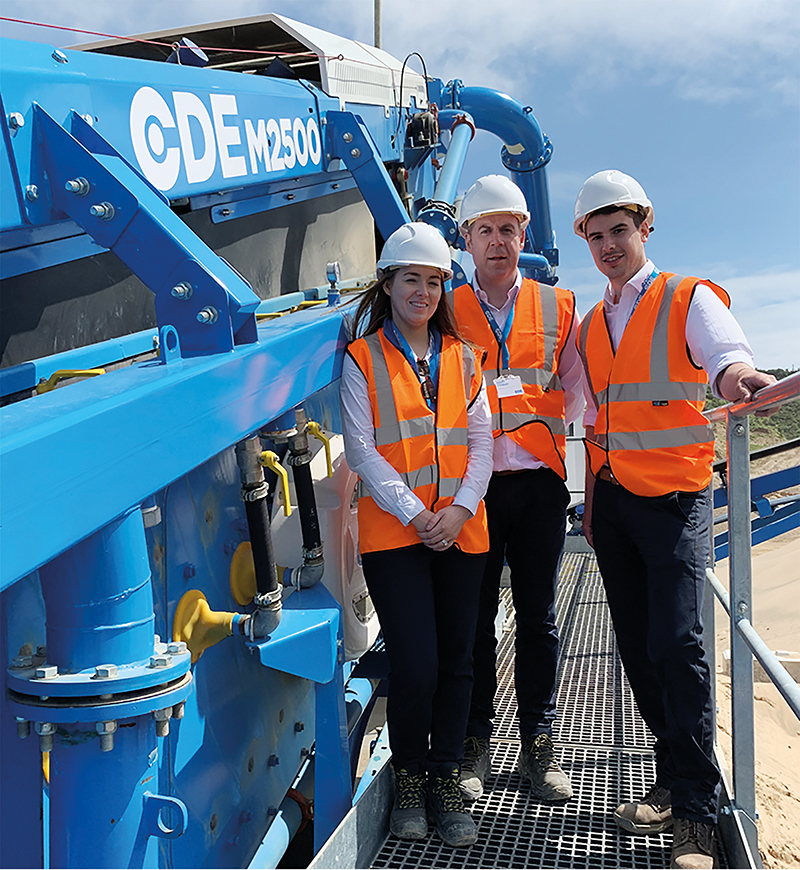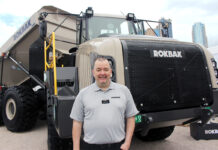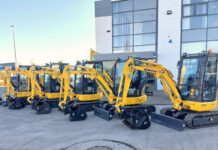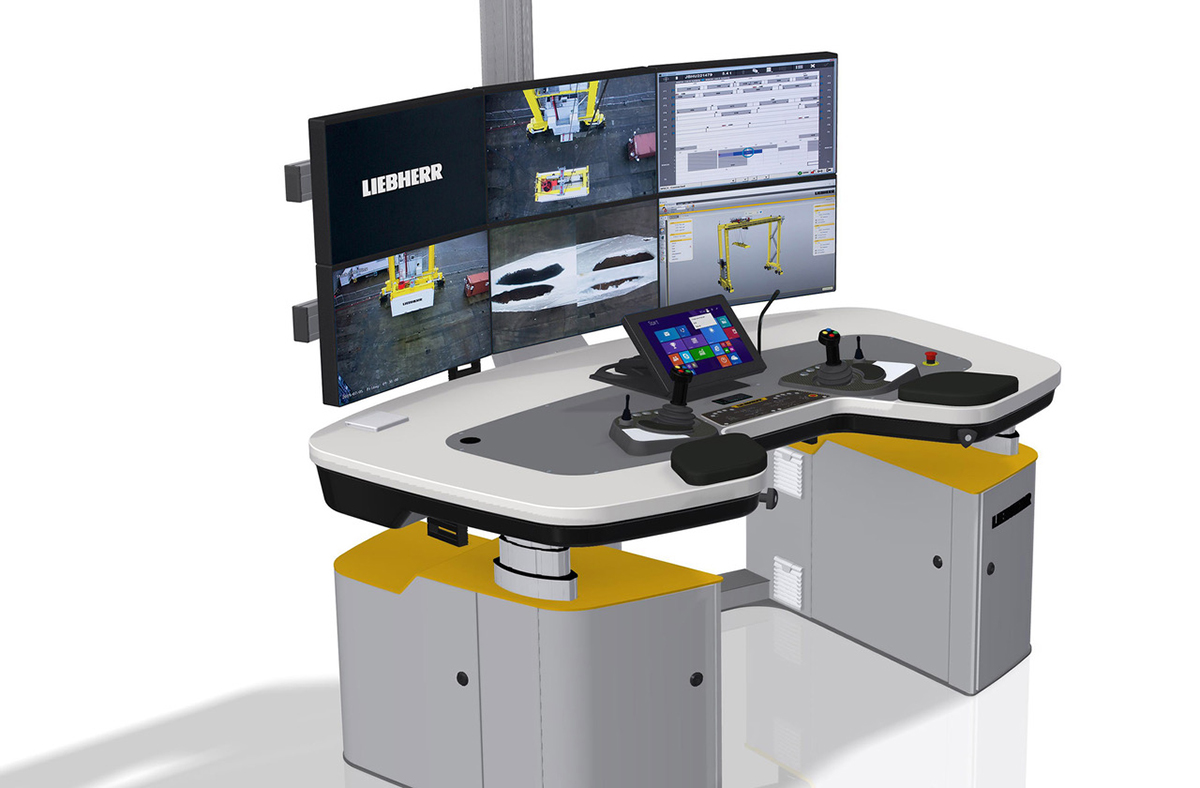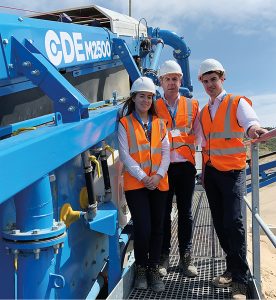
Cookstown-based CDE have provided a bespoke M2500 E4 washing plant to D’Arcy Sands. The plant is based in D’Arcy’s sand pit in Blackwater, Co. Wexford. CDE took the opportunity to let new and existing customers see the plant in action and held open days on 25-26th June. Of course, when we heard there was an interesting piece of kit on show, it wasn’t long before we were on the scene.
“Having open days like this is very important to us. It’s a great way to get people onsite who we would like to see our products”, says Garry Stewart, Business Development Manager with CDE. “We’re very pleased with the turnout here. We appreciate people taking the time out of their schedules to travel and see this.”
The plant is being used to produce two stone products, grit, and a high-quality, fine sand. This sand is used on golf courses, sports fields and for equestrian uses.
“The installation of this plant has taken D’Arcy Sands to a new level. There is a great demand for the quality of sand they’re producing”, says Garry.
Wexford washers
D’Arcy Sands had never washed at the Blackwater site before. Instead, they had been drawing material to a site some distance away, where they had an older Powerscreen plant. The age of this plant and the cost involved in transporting the material encouraged D’Arcy’s to make a change. “We had been using a Powerscreen Chieftain 1400 fitted with a wash box since 2006, and it was time to upgrade”, says Tony D’Arcy, manager at D’Arcy Sands. “We were drawing the material to a site in Castlebridge, seven miles away. With the cost of diesel and insurance going up, it was getting more expensive all the time. We decided to go for planning for a wash plant here in Blackwater, so we could keep everything onsite.”
“CDE came on board and brought our water recycling technology with us, and we provided a solution for D’Arcy’s”, explains Garry. They have drilled three wells on site, and they are used for water top-up. We’ve got an A200 AquaCycle, which is capable of handling 200m3 an hour. We’re finding in practice that we’re using a 5 percent top-up, which is 10-12 cubes per hour. That’s typical to keep this plant going at a feed rate of 80-100 tonnes per hour.”
Gary talks about the process involved in beginning an installation like this. “The process begins with CDE visiting the customer, assessing the site, and taking a sample of the raw feed material. We then design and manufacture a bespoke solution for the customer”, he says. Tony describes some of the benefits the company has found since investing in the new washing plant. “We’re happy with the output of the plant. We are washing stone now as well as silica sand, which we’ve never done before. The stone is beach pebble. It’s a nice colour, so we’ve been selling a bit of that for driveways and that type of thing. We’re now producing four products that are ready to go, and have more options going forward regarding sizing of material”, he says.
Tony is also satisfied with the aftersales support they have gotten from CDE. “Garry or some of the lads are always on the end of the phone immediately if there’s an issue or you want something changed”, he says.
How it works
Garry goes into detail about how this tailor-made M2500 works. “The material is fed by a loading shovel into a 14m3 feed hopper. This goes up to a P2-75 screen, which is a two-deck screen with a 7.5m2 area per deck. There are polyurethane modules fitted to each deck. On the top deck, this is 14mm, and on the bottom deck, the first two thirds are 2mm, and the last third is 6mm. That’s how we’re producing two materials from the bottom deck. The top deck is producing 14/20, we’re producing 16/20 from the bottom deck overflows, and our 6mm grit goes into a small sump below the screen and is pumped directly to the dewatering screen using a jet pump. Here, spray bars will knock off any residual sand. It then goes into a sump and joins 0/2 material, which is pumped up to a 625 Cyclone using a rubber-lined pump. The 625 Cyclone removes any material below 63 microns. It then exits the bottom of the Cyclone and moves on to the dewatering screen, where it is dewatered and stockpiled. Typically, it comes off at 12-15 percent moisture, which means it can be loaded onto trucks and brought to sites straight away, though it’s often left to sit for an extra day to dry more”, he says.
CDE try to carry out as much of the manufacturing and assembly as possible at their plant, in order to speed up installation on site. The M2500 has a modular design, making assembly faster and easier. “We provided them with a set of civils drawings for the concrete. Once that was done, we could begin installing the plant”, says Garry. Installation typically takes five to six weeks. This includes two or three weeks for the mechanical assembly, followed by electrical and commissioning work.
Golf sand is a hole-in-one
D’Arcy Sands has its headquarters near Tinahely, Co. Wicklow. The company was set up by Tony’s father Anthony in the mid-1970s. In those days, the company provided sand and gravel for the construction industry. By opening the Blackwater pit in the early ‘90s, however, D’Arcy’s found a new product with a niche market. “My father came down here looking for concrete sand. At that time, they started using a USGA-spec sand for golf courses. The high-draining silica sand here happened to be the exact sand that was needed for that. We started doing golf courses, then went from there to football pitches and equestrian applications”, explains Tony.
There has been a steady demand for this product over the years. The necessity of maintaining golf courses and pitches even kept them out of the rough during the recession, though Tony says business has picked up in the last few years. “It has gotten busier. There are a lot of equestrian facilities in particular, as well as football pitches. There is more maintenance of golf courses too – more people are back playing golf and there are more tourists coming to some of the clubs we provide maintenance sand to”, he explains.
Waste not, want not
One area CDE have been focusing their efforts on is enabling quarries to process and sell materials which previously would have been considered waste. “Dust and clay-bound overburden materials are a huge problem on some sites. CDE has proven solutions for this, and we can bring Irish customers to England or Europe to see those plants working”, says Garry.
“There is only a finite amount of resources in Ireland, and we have to use materials that we may have shied away from in the past. CDE now have the equipment and the technical knowhow to handle these materials”, he says. “The sand here in D’Arcy’s is exceptionally clean. We handle materials with up to 30 percent silt with our recycling plants on a daily basis on some sites in the UK”, he adds.
About CDE
CDE employs around 650 people in its three bases in Cookstown; Cleburne, Texas and Graz, Austria.
Business is currently good in Ireland, says Garry. “We had a really good foothold in the market in the early 2000s. Those customers went through a rough time during the recession, but we’ve found a lot of people who bought equipment from us in the Tiger era are coming back again to upgrade. Customer loyalty is good”, he says.
CDE is a diverse business and is currently separated into five divisions. “We have CDE Primo – our sand and gravel business, CDE Reco, for construction and demolition waste, Enviro – for materials like road sweepings and municipal waste, Solv – for glass manufacturing and sands, and Meta – for mining”, explains Garry.


